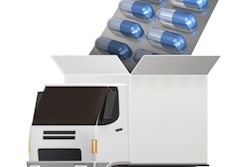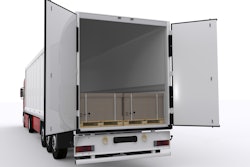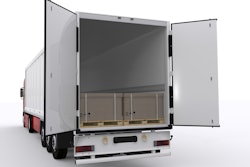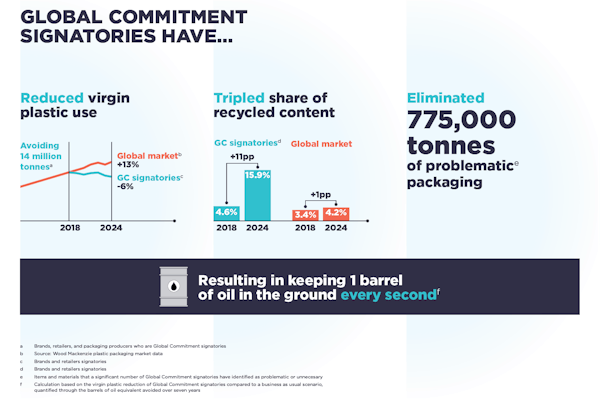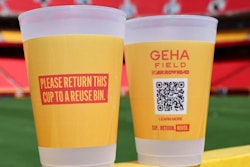Like most retailers today, Walmart Stores has its eye on e-commerce, the rapidly evolving electronic transactions market. More than half of all U.S. consumers now possess smartphones, the enabling technology giving shoppers anytime, anywhere access to warehouses filled with inventory.
E-commerce already accounts for a $1.3 trillion slice of the $22 trillion global retail pie, according to digital market tracker eMarketer, Inc.
Between 2013 and 2018, online grocery sales will grow at a compound annual growth rate (CAGR) of 21.1%, reaching nearly $18 billion by the end of the forecast period, according to a recent analysis by Business Insider. “For comparison,” notes BI, “offline grocery sales will rise by 3.1% annually during the same period.”
How the digital market phenomenon will affect the primary and secondary packaging of Walmart’s private brands packaging was the topic of conversation when we spoke to Chet Rutledge, director/packaging, Private Brands, Walmart. Here’s an edited transcript of our exchange.
Ben Miyares:
As we move deeper into the 21st Century, do you see the traditional retail venue going away?
Chet Rutledge:
I don’t think we’ll see it in our lifetime, but it’s going to continue to evolve. There will be format changes to meet changing customer demand. We must continue to change and evolve in order to stay ahead of the curve. Where things are going is the challenge that we, and every other retailer, faces. But one of the things, from a Walmart perspective, is that we are uniquely positioned with over four thousand stores and well defined distribution channels to bridge the gap between digital and physical retail. We’re in 27 different countries.
What is Walmart’s interest in e-commerce?
We are very interested in e-commerce because it’s a growth engine for the future and there’s a lot of opportunity there for us. We’ve seen exponential growth in our dot com business as it is. And we think there’s e-commerce growth opportunity not only here in the US but globally as well.
How are you defining e-commerce?
It’s probably defined differently by different people but I look at it as, basically, any electronic means of commerce. That could be through our Walmart.com site or through mobile platforms. There are so many different access points. It could be an order for some goods that you found online that you ordered through your smartphone or your iPad or online. The opportunity then becomes, for us, should it ship direct from a warehouse somewhere in cyberspace or does it come to a store and get picked up by the customer during a regular shopping occasion? It presents a multitude of different opportunities.
We’ve got well over five thousand Walmart and Sam’s stores here in the US that are figuring out how we make digital and physical a seamless shopping experience for our customers. We’re uniquely positioned so that our customers can order online and pick up their orders at their neighborhood store. And how do we make that work? As technology continues to advance we see our customers relying more and more on e-commerce. We have to adapt to the fast changing, fast moving landscape. That’s where the big opportunity is going to be. The packaging challenge becomes much more complex but it also creates some great opportunities for packaging professionals. Developing product delivery systems to meet the variety of product channels will require us to look at the total system and not just individual steps along the supply chain.
Doug McMillon our CEO calls it bridging the gap between digital and physical. The challenge and the opportunity through e-commerce and mobile is creating the ability to offer anytime, anywhere access and combining it with our physical stores.
Could this mean smaller format stores? I think so. Because by connecting via e-commerce I can take a small store that maybe only has 25 thousand items on the shelf and create an opportunity similar to the super center. We certainly can do that by connecting the stores to the customer via dot.com, giving the customer access to as many as four million items with the convenience of a local store.
What are Walmart’s private brands?
Some of our Private Brands include Great Value, Sam’s Choice, Equate, Marketside, Ol’ Roy, and Parent’s Choice. We offer opening price point items as well as national brand equivalent (NBE) and premium products.
Are any of these tiers better suited for e-commerce?
NBE and Premium products seem most logical for e-commerce, but value is always a key factor in most customers’ buying decisions so I think all three tiers present opportunities for e-commerce.
Are Walmart’s private brand products more or less appropriate for omnichannel (e-commerce) marketing compared to national brands?
Private Label products are just as appropriate for omnichannel but are often less recognizable than national brands. We continue to work on improving our private label products and focus on bringing quality products that provide a value for our customers.
What changes, if any, to in-store shelf packs would enhance the e-commerce sales appeal of Walmart’s Private Brand products?
Packaging versatility becomes more challenging than ever. Packaging designers have to think more broadly and anticipate more handling and performance requirements. What’s worked in the past may not work in the future. I think this is the new packaging frontier.
Is Walmart considering Private Brand product package designs exclusively for e-commerce sales?
Currently, I’m not focusing on packaging designs specific to e-commerce. My focus is for in-store use. I have to look at packaging design with a multi-faceted approach. It has to survive through the supply chain to the store, must be easy to execute at the store and interact with the customer. We have our dot.com team focused on the e-channel.
What package design elements do you consider critical for success in the e-commerce marketplace?
High-performance materials that can be lighter yet stronger—both paper and polymer-based—are critical. They must protect the product but allow for minimal material usage. Not an easy task to achieve.
When I see a commercial in print or on TV for a cleanser that is available exclusively at Walmart and go to the store and buy it, that’s not e-commerce. But, if I saw the product online and went to the store to buy it, or bought it online for in-store pickup, or ordered the detergent online with my smartphone or whatever, it would be e-commerce.
Yes. That’s how I would classify it.
How has e-commerce changed in the past five years, and how is it likely to grow in the next five years?
The growth has been exponential. We’re light years ahead of where we were five years ago. Looking back over the past few years “Black Friday” kicked off the holiday shopping season. It has expanded to Cyber Monday with online ordering to the point where you now order products in between Thanksgiving dinner and dessert.
What’s driving this growth?
Well, we’re getting more and more connected. Our data suggest that over half of our shoppers have a smartphone. Many of them are using their smartphones to connect with social media. They’re ordering products online, and a lot of them are actually using their smartphones in the store to see if anybody else has a better deal.
Do you encourage or discourage that?
We encourage it.
You’re pretty confident, then, that Walmart is going to have the best deal?
Yes. Our business is founded on everyday low pricing and we intend to be a price leader.
Right now packaging is not doing much to stimulate e-commerce purchase. How might that change?
What if the package code notified the store that you needed a replacement?
What do you see as the unique challenges of e-commerce packaging?
The package is not selling the product as it does on the shelf, in the brick and mortar retail scenario. One potential advantage of packaging designed for evaluation online is that the product can be viewed from a variety of angles and perhaps even manipulated.
If I see a toy truck online I can turn it around. In the store, it’s on the shelf and it’s in this package and it’s tied in place and surrounded by protective packaging so it can survive through distribution undamaged. But it’s also decorative packaging…
From a manufacturing standpoint, you’re faced with some real challenges. You’ve got a unique on-shelf presence that you don’t necessarily have online. Do you really need all the packaging graphics if the product is going to sell online? You could say, “Well no. I don’t need a decorative package that has an on-shelf presence. I could put the product in a more economical brown box for shipping.” But that creates a dilemma for the toy manufacturer. Now he’s got multiple types of packaging for that single product. It will continue to be complicated because of the mix of sales and the forecast … Which packages and how many of each, should they make? Can they pull products and packages from inventory? How do they make all that work? That’s the secret sauce.
E-commerce becomes another class of trade. Manufacturers are already packaging products in different ways for sale in drug stores, supermarkets, convenience stores, club stores, whatever. They may have to set up separate lines for e-commerce sales where they don’t have the display package, just the protective package. And, yet, at the same time, to get the product to whatever the point of receipt is on the selling side, whether it’s a distribution center, an e-commerce warehouse, a retail store or not, it’s got to be protected and it’s probably not going to go out one toy truck at a time. It’s going to be in multiples. So how do you protect the parcel without all that packaging? Has that been worked out yet?
No. And you’re exactly right. E-commerce is a unique channel and it creates some very unique distribution challenges, from a manufacturing standpoint, from a supplier standpoint, from a retailer standpoint. Which package do they put it in? Here’s another thing. On the selling side, what if I could ship the product direct from the manufacturer and not even have to take it in to a distribution center? That’s another avenue that has potential. It’s not totally uncharted territory but it’s still pretty undefined.
I look at packaging as a delivery system for the product, whatever that product is. I’ve got to be able to deliver that product from the point of manufacture to the point it gets to the customer and their interaction with the product. Typically if the packaging is done right and the customer reaction to the product is positive, the customer doesn’t even think about the package. They think about how good the product is.
In the e-commerce channel, it’ll go to a distribution center where it gets taken out of a bulk pack and is shipped as a single item. Typically, it goes as a parcel versus a palletized load, so the package doesn’t have the support of all the other packages nestled nice and tight next to it.
So the individual product parcel will require more protective packaging?
Ah-hah! That’s the challenge of e-commerce. When it gets to your house, you want to make sure that the product in the package is in pristine working order. At the same time you don’t want it to appear over-packaged. The consumer doesn’t want to get something that’s the size of a pack of gum packed in a box that’s about one foot square. That prompts the consumer to ask, “Did I really need all of that packaging?” It’s a balancing act: how do we protect the product appropriately and yet not over pack it?
It certainly is a lot tougher to appropriately package perishable foods and drugs than soft goods, which may need little more than a padded envelope with a postage paid label for returning the item if it’s not right.
You’re exactly right. But, what about perishable products—something that has to be refrigerated? How do I ensure cold chain integrity? What happens if that product is temperature abused? It’s not going to be good. It could potentially be dangerous.
More concerning, perhaps, how does the manufacturer/producer, the retailer, or the merchant—whoever sold it—know and assure the consumer and protect themselves from the liability of whatever might happen?
That is one of the things that keeps me awake at night.
The retail industry established the so-called “five easies” that needed to part of any self-respecting Retail-Ready Packaging (RRP): Easy to identify, open, replenish, shop, and dispose of or return. Is there anything comparable for e-commerce packaging?
That’s a great question. But, no, it’s not packaged quite that nicely. But there are things you have to look at. It goes back to the delivery system. And you’ve got to look at how all the components interact with one another because the e-channel is a particularly difficult distribution system. You’ve got to make sure that all the components play nicely with each other. There are unique requirements of the specific products themselves. Perishable products have a completely different set of packaging requirements versus a silk shirt and pants.
To date a lot of e-commerce has focused on non-food and drug items, such as electronics, hardware, and soft goods. But we’re not seeing too much in the way of foods, beverages and cosmetics. Do you expect that to change?
Yes I do. There are a lot of apps for your smartphone that are either about e-commerce, quick recipes, or food type applications or services. There’s a service where you can place an order for a coffee, breakfast, or whatever and have it delivered to your house. We are seeing more and more of that. Amazon Fresh is one of them. That’s an area we’re looking at. Food presents unique challenges … fresh items, refrigerated items, frozen items … How do you transport those? There are a lot of challenges there.
We’re testing e-commerce in several different markets right now in small-format stores. In Denver we’ve got a customer pick up scenario where the customer goes online, places an order, and picks it up at the store. In Bentonville, Arkansas, and in Birmingham, Alabama, we have another e-commerce approach. There, you place your order—a gallon of milk, a loaf of bread, and a roast for dinner. You indicate when you’ll be able to pick it up and you get a response back. “Here’s your queue. Pull into queue lane number four during your requested timeslot and your grocery order will be delivered to you.” That’s e-commerce right to your car on your drive home. We’ve seen some of this in the UK where there are kiosks and lockers as you get off the subway. You place your order, receive an email confirmation code and a locker number, then you get your groceries on the way home. We’re exploring a lot of different things. We have to evolve.
It’s a unique opportunity that has not been fully defined but will be really interesting and challenging for the near future. Many of us would agree that the retail channel is challenging. I would say that getting the e-commerce channel right is even more challenging.




